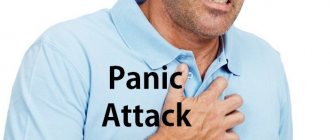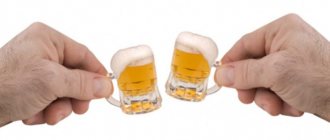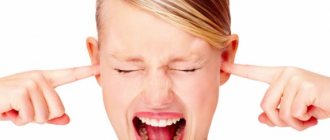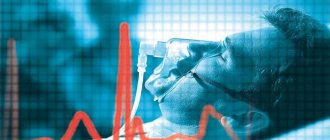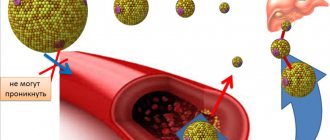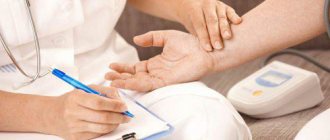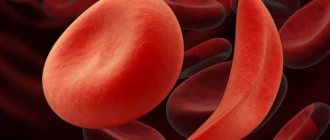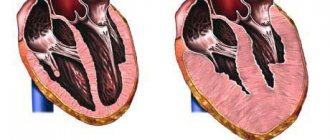Animal fear without visible physical threat in a dream or in reality. This is not a quote from a horror book, but the reality in which patients with panic attacks live. Mental disorder loves the young and active. The lion's share of patients with this diagnosis are people between 20 and 30 years old. Chronic illness is accompanied by physical and emotional suffering.
On the part of panic attack survivors, the worst thing for them in this state is depersonalization and derealization. It seems to a person that he is not in his native environment (although this may be his father’s house) and not in his body. It's scary, freezing from the inside. The worst thing is that a panic attack does not choose the place and time for the attack. Exacerbation may occur:
- in a traffic jam;
- on public transport during rush hour;
- at a crowded meeting or during a one-on-one conversation with a manager;
- at business negotiations or at home at the family table.
Symptoms and signs of a panic attack
The attack occurs suddenly, and the strength of the symptoms is impossible to predict. Neurologists and psychotherapists have noticed that they provoke a panic attack:
- long-term stress factor. Illness or death of a loved one, a stressful period at work or school, unrequited feelings, divorce;
- hypercontrol. Perfectionists, accustomed to keeping everything under control and doing it perfectly, are at risk of panic attacks;
- staying in open crowded areas. In psychology, the concept is called “fear of the marketplace.”
A panic attack can begin at any time and anywhere.
These or alternative stress factors trigger a reaction of the autonomic nervous system that is inadequate in strength and duration. An excess amount of adrenaline enters the bloodstream, causing symptoms:
- difficulty swallowing. During a panic attack, it is difficult for a person to swallow water or take a breath. It seems to him that he might choke on his own tongue or air;
- increased sweating. The person’s palms, face, and back suddenly become wet;
- difficulty breathing. The chest seems to be bound by iron hoops. Difficulty inhaling or exhaling deeply. Shallow and frequent breathing causes hyperventilation of the lungs, dizziness begins, and nausea appears;
- hypertension and tachycardia;
- heartache. During an attack, patients think they are experiencing a heart attack. It stings so much, presses and cuts in the chest at the same time;
- discomfort in the stomach, pain in the intestines, feeling of nausea.
A panic attack lasts from 3 to 15 minutes. Depending on the neglect of the condition and the degree of damage to the autonomic nervous system, people can suffer from manifestations of the disease from 1-2 times a month to several times a day, which significantly complicates maintaining a socially active lifestyle.
How to distinguish a panic attack from other problems
A panic attack feels like something very serious, but in reality it passes without a trace. If you have the slightest doubt about the reasons for what is happening, be sure to call an ambulance. One thing distinguishes a panic attack from any other serious attacks that are dangerous to health and life: the symptoms do not intensify, but disappear after 10–15 minutes. Let's figure out how to distinguish a panic attack from other conditions that are truly life-threatening.
| Heart attack | Panic attack |
| During a heart attack, chest pain may go away, but then return and last longer than 10 minutes. Discomfort and heaviness in the upper body, unpleasant sensations in the left arm. The pain does not affect breathing. Fear is caused by chest pain. | Symptoms peak within 10–15 minutes and subside. The sensations are not limited to the left arm and resemble tingling rather than heaviness. Breathing is difficult. Fear is irrational. |
| Stroke | Panic attack |
| Sudden numbness or weakness of the muscles of the face, arms or legs, sudden blurred vision, unsteadiness of gait, loss of coordination, severe dizziness. It’s easy to check by trying to smile, speak, or raise your hands. If one side of the face is hard to hear, speech is unintelligible, and the hand does not obey, immediately call an ambulance. | Mild muscle numbness and dizziness may occur, but the pressure rarely rises above 180\120 mmHg. Art. There is no asymmetry in the smile or movements. Thoughts are confused, but speech is clear. |
| Mental disorder | Panic attack |
| Symptoms go away slowly, panic lasts longer, triggers cannot be classified. The frequency of attacks increases and is accompanied by additional problems - insomnia, aggression, confusion. A person is inclined to justify an attack with irrational reasons: magic, damage, the influence of an alien intelligence. | The symptoms disappear without a trace, the triggers are clear, the person is able to describe the symptoms in detail and intelligently. Personality does not change. |
| Epilepsy | Panic attack |
| Sudden and unpredictable onset of an attack. Duration from a fraction of seconds to several minutes. Attacks can follow one after another. Convulsions, speech impairment, inability to control movements. Personality change. | Attacks occur under the same or similar conditions - fatigue, stress, confined space. Duration from 5 minutes to half an hour. During a panic attack, the body is objectively under control, although the brain does not immediately realize this. Personality does not change after the attack. |
It is important to distinguish a panic attack that goes away on its own from conditions that require immediate medical attention.
Why are panic attacks dangerous?
At the peak of a panic attack, a person loses his sense of connection with reality. If he is on the subway, then due to dizziness and panic, he may fall from the escalator or onto the rails, injuring himself. Also during an attack the patient is helpless. It is easy to steal or cause physical harm.
As for outsiders, panic attacks may be regarded by friends, family, and colleagues as hysteria, theatricality, or pretense. Without realizing the seriousness of the situation, they make things worse for the patient, exacerbating his depression, uncertainty, and apathy.
Conversation with superiors is a trigger for an attack
Causes of panic attacks
The causes of panic attacks most often lie in the diseases from which the person suffers, as well as surgical interventions performed and mental pathologies.
A separate issue is taking medications, some of which can cause panic attacks. Such manifestations are caused by taking drugs used in the treatment of neurological and psychiatric diseases, as well as for intensive care. This is due to the presence of components in them that increase a person’s anxiety.
The origin of panic attacks that occur both at night and during the day is caused by the following drugs:
- causing increased formation of cholecystokinin, a hormone that acts as a regulator of feelings of fear and anxiety (obvious manifestations of panic attacks): they are used for diagnostic studies of the gastrointestinal tract and relief of withdrawal syndrome during withdrawal;
- CNS stimulants - steroids that cause panic attacks: prednisolone (used to treat asthma), danabol (anabolic steroids);
- bemegride, used to put the patient under anesthesia and treat barbiturate overdose: can cause nocturnal panic attacks due to its ability to cause hallucinations
What to do during a panic attack?
If an attack begins, then:
- Find a wall or table to lean on.
- Clasp your hands. This will allow you to regain concentration and awareness of your own body.
- Stop hyperventilation. Take a slow deep breath (4 counts), exhale for 4 counts and pause for 2 counts.
- Close your eyes and listen to sound, smell or tactile sensations.
- After 2 minutes, drink some water in small sips.
Also, neurologists and psychologists categorically do not recommend changing location during an attack: running somewhere or going out. Wait for the attack to end, then calmly continue your work.
How to cope with a panic attack yourself
My attacks most often occur at night, when no one is around. The first thing I do is immediately turn on the light and any movie or TV series (not a horror movie) so as not to feel alone. Silence and darkness cause even greater fear.
It may seem that the panic will not go away and you will no longer be able to control yourself. But that's not true. There are several ways to calm down Panic Attacks & Panic Disorder: Symptoms, Causes, and Treatment.
Breathe deeper
During an attack, shortness of breath may occur, and the person feels that he is not in control. Tell yourself that shortness of breath is just a temporary symptom and will go away soon. Then take a deep breath, wait a second, and then exhale, mentally counting to four.
Repeat the exercise until normal breathing is restored.
Relax your muscles
This will give you back control of your body. Clench your palm into a fist and hold it in this position, counting to 10. Then unclench and completely relax your hand.
Try also tensing and relaxing your legs, and then gradually move up your body, touching the buttocks, stomach, back, arms, shoulders, neck and face.
Repeat a positive attitude
Try saying a few encouraging phrases to yourself or out loud. For example: “This is temporary. I'll be ok. I just need to breathe. I'm calming down. Everything is fine".
Focus on an object
Study it to the smallest detail: color, size, pattern, shape. Try to remember other objects similar to it. Compare them with each other, mentally find the differences. This will help you distract yourself and think less about the fear you are experiencing.
Open the windows
If you are in a stuffy room, fresh air will help you come to your senses.
Panic attacks during sleep
The insidiousness of the attacks is that they are possible not only during the day. Seizures are not horror dreams. They most often occur between 12 noon and 4 am.
During an attack, a person wakes up or is in a borderline state and experiences all the symptoms. After the attack he can continue to fall asleep.
With the onset of the disease there are 1-3 night attacks, in advanced stages - up to 5 in one night. This drives you into a state of depression, a person is afraid to fall asleep, cannot relax, and succumbs even more to stress.
Features of the course of panic disorders in children and adolescents
Hormonal changes in a growing body are ideal conditions for the onset of panic attacks. Teenagers experience their first attacks at the age of 12-13 years, but even preschoolers are not immune from them. Due to the high sensitivity of the psyche, there are more girls among children diagnosed with a panic attack.
Symptoms during attacks are more pronounced than in adults. Pseudoparesis, involuntary acts of defecation and emptying the bladder are added to the classic manifestations of panic attacks.
Without treatment for adolescents and children, the condition worsens. Fainting and tachycardia appear more often, the patient experiences panic when visiting new places, fear of meeting people or moving independently. Neurologists at the Clinical Center for Autonomic Neurology do not use drugs or hypnosis to treat panic attacks. Therefore, they have many positive reviews and good dynamics of stopping seizures forever in children and adolescents.
Panic disorders
Various types of disorders can also act as triggers for panic attacks.
- Anxiety disorder with elements of phobias: includes several types of anxiety, often found in the presence of schizophrenia and some other mental pathologies. It manifests itself as pronounced anxiety, suspicion and delusional ideas about persecution, possible poisoning, accompanied by hallucinations.
- A disorder that arose as a result of experienced stress, resulting in a violation of adaptation: often, this problem arises after a person receives burns, or gets into a serious accident, flood or earthquake. Panic attacks in this case are associated with a subconscious fear of being in a traumatic situation again.
- Adaptation disorders are quite rare: typical manifestations of this condition are sleep problems, aggressive behavior and loss of appetite.
- Obsessive-compulsive disorder: is expressed in a person’s fear of contracting terrible diseases that can lead to his death. Panic attacks caused by this disorder most often occur during adolescence.
- Phobias (obsessive fears): relate to a specific situation, place or object. Characteristic signs of this condition are pointless fear, panic, and disturbances in motor and respiratory functions.
Seizures in women during pregnancy
Panic attacks in expectant mothers are provoked by sudden changes in hormonal levels and severe stress before the upcoming birth. During an attack, expectant mothers feel suffocation and severe tachycardia, pain in the abdomen and heart, fear of losing consciousness, falling and harming the child. The complexity of treating panic attacks in this category is complicated by the impossibility of using antidepressants and other medications due to the threat of fetal development pathologies.
During a panic attack, pregnant women feel a strong contraction of the muscles of the abdomen and uterus
Complications of panic attacks in expectant mothers manifest themselves in the form of sudden muscle contractions, including and uterus. Because of this, the threat of miscarriage increases several times even against the background of a normal pregnancy.
Over the years of practice, neurologists at the Clinical Center for Autonomic Neurology have repeatedly encountered pregnant women diagnosed with panic attacks. Diagnostics that are safe for the woman and the unborn child and non-drug therapy allow us to achieve positive results.
Why panic attacks are dangerous
Single episodes are usually harmless. But panic attacks need to be treated if they recur, otherwise they will develop into panic disorder. Because of it, a person lives in constant fear.
There are other complications of Panic attacks and panic disorder:
- Specific phobias. For example, fear of driving or flying.
- Problems with performance at school or college, deterioration in performance.
- Closedness, reluctance to communicate with other people.
- Depression or anxiety disorders.
- Thoughts about suicide, up to attempts to commit suicide.
- Alcohol or drug abuse.
- Financial difficulties.
Panic attacks in men
Stress at work and the constant desire to maintain high social activity play a cruel joke on the stronger sex. The parasympathetic nervous system ceases to resist the chronic stress factor and panic attacks develop.
A sharp increase in adrenaline in the blood during an attack provokes an increase in blood pressure and the accumulation of lactic acid in the muscles. As a result, the heart pounds in the chest, a feeling of heat appears in the chest, legs and arms are stiff and partially immobilized. Over time, an obsessive thought about repeat attacks, fear of loss of socialization and activity, apathy and depression at home and at work develop.
Somatic diseases
Panic states that develop in the presence of concomitant diseases are classified as a type of somatized anxiety. In other words, the patient’s feelings about the disease, as well as its manifestations, act as a stimulus for the development of the attack.
Symptoms of panic increase gradually and include the following symptoms:
- instability of emotions;
- depression;
- the appearance of chest discomfort;
- heartache;
- dyspnea;
- anxiety.
Panic attacks may be accompanied by the following pathologies:
- heart disease (experienced heart attack, accompanied by pain that the person remembers, coronary disease, as well as mitral valve prolapse);
- physiological periods (menstruation, onset of sexual activity, pregnancy): occurring with changes in hormonal levels;
- diseases of the endocrine system (tumor formations of the adrenal glands, thyrotoxicosis): provoke panic when blood pressure levels rise, resulting from an increase in the amount of adrenaline in the blood;
- use of medications.
Panic attacks and vegetative-vascular dystonia
Neurologists at the Clinical Center for Autonomic Neurology identified panic attacks and vegetative-vascular dystonia as having the same nature - a disruption in the functioning of the autonomic nervous system. Regional nerve ganglia (ganglia) begin to become inflamed. Inflammation may be autoimmune in nature. In the initial stages, the body’s reserve is sufficient for pathology in the ganglia to occur asymptomatically. But severe or prolonged stress wears out the nervous system.
Depending on the location of the inflamed node, a person is tormented by symptoms of dysfunction of various organs and systems. Modern diagnostic methods MRI and CT detect abnormalities, but cannot detect the culprits of the pathology. And the person suppresses the symptoms with antidepressants and psychotherapy, treats healthy organs instead of eliminating inflammation in the ganglia once and for all.
Symptoms
Here are a few symptoms that occur during a panic attack:
1. Heartbeat. A heart beating very fast, hard, or irregularly is one of the key symptoms. Because the brain thinks this is a dangerous situation, the heart beats even faster and harder to send more blood to the muscles. This makes the body ready for action, such as running away or fighting.
2. Difficulty breathing. Another symptom of PA is when you feel like you can't get enough air. You start breathing faster to get more oxygen into your blood. Muscles need oxygen to work. You feel that it is difficult to breathe and you are suffocating. In the process of hyperventilation, you “release” carbon dioxide from the blood. This causes a series of new symptoms: dizziness and tingling in the fingers and around the mouth.
3. Chest pain. When breathing deeply and quickly (hyperventilation), the muscles in the chest wall become tense and painful. This causes symptoms such as chest pain or heaviness.
4. Sweat. The body sweats to cool down. This is another way to prepare for a forceful activity, such as a fight or run.
5. Dizziness. This symptom appears due to hyperventilation and active release of carbon dioxide. This causes the blood vessels in the brain to contract. In a real combat situation, the muscles produce new carbon dioxide so that the level in the body remains normal.
6. Feeling of suffocation. This symptom is associated with oxygen starvation caused by hyperventilation. The body automatically weakens the activity of the gastrointestinal tract. Thus, the muscles receive more energy. This results in less saliva production, dry mouth, and a feeling of choking or a lump in the throat.
7. Nausea or upset stomach. As already mentioned, the body saves energy by reducing the activity of the digestive tract. As a result, food will remain in the stomach longer. This causes nausea or vomiting.
8. Tingling and numbness around the mouth, arms and legs. This is due to hyperventilation, which changes the pH (acidity of the blood) and affects the nerves in the mentioned areas.
9. Trembling. Causes muscle tension, which in turn signals that they are ready for action.
10. Feelings of cold and heat. Depending on the situation, a person feels warm or cold, or first one and then the other symptom. The more blood that reaches your muscles, the less that reaches the surface of your skin. It makes you feel cold. Or blood vessels open and move blood to the surface of the skin to cool the body. This causes a symptom such as a feeling of heat.
11. Feeling of unreality. You experience it as if things around you are not real or as if you are looking at yourself from the outside. This happens because the brain disengages from the horror. This symptom makes the situation worse because it is mistakenly considered a sign of insanity. Many doctors and psychologists do not realize that this is a typical sign of panic disorder and not a mental illness (psychosis or schizophrenia ).
Diagnosis and search for the root cause of panic attacks
Panic attacks have long been attributed to mental disorders, and various somatic symptoms were sought in other organs and systems. In 1998, American scientists made a coup. During radioimmunological diagnostics, they discovered the cause of panic attacks - inflammation of the autoimmune nature of the nodes (ganglia) of the autonomic (peripheral) nervous system.
“For the last 100 years, scientists have interpreted a wild feeling of fear, the fear of choking on air or a sip of water as a hysterical lump. Psychotherapy and antidepressants were prescribed. Although the reason is the inflamed autonomic ganglia of the cervical-collar area. Using computer thermography, we observe the problem in real time and begin to eliminate it without drugs or hypnosis.”
A. Belenko, neurologist, candidate of medical sciences, author of a method for treating disorders of the autonomic nervous system
The head of the Clinical Center for Autonomic Neurology, A.I. Belenko, became interested in the developments. He noticed that depending on the location of the affected node in that part of the body, characteristic symptoms arise. When the solar plexus ganglia are damaged, a person has stomach pain and an ulcer is suspected. Gastroenterological studies do not reveal the cause, and antiulcer therapy is ineffective.
“There was a case in my practice. A patient was admitted with symptoms of diffuse inflammation in the abdominal cavity. MRI, CT, and other instrumental methods did not detect neoplasms or other anatomical and physiological abnormalities. I sent him for computer thermography. The picture revealed black holes piercing the stomach. These were inflamed areas with impaired innervation and blood supply in the area of the solar and hypogastric plexuses.”
A. Belenko, neurologist, candidate of medical sciences, author of a method for treating disorders of the autonomic nervous system
Autonomic nerve nodes are responsible not only for innervation (reception, processing and transmission of impulses), but also for thermoregulation. The diagnostic method, computer thermography, is based on this principle.
The thermal imaging camera is aimed at the area or the entire body of the patient. An image is taken in real time showing the activity of the ganglia and the presence of autoimmune inflammation in the nerve ganglia.
Diagnostics with a thermal imager:
- prompt;
- does not require preparations, diets, or changes in the patient’s lifestyle;
- Suitable for adults and children, people weakened by chronic diseases, pregnant and nursing mothers. During the procedure, the body does not receive radiation;
- the operation of the device does not affect pacemakers or metal implants (dental crowns, orthopedic structures);
- the ability to monitor the treatment of panic attacks or VSD;
- high sensitivity. The device responds to temperature differences of 0.1 degrees.
In addition to computer thermography, cardiac rhythmography is used. The method comes from space medicine. An ECG at rest, with minimal physical activity and during the recovery period records the work of the parasympathetic division of the autonomic nervous system. It is he who is responsible for mobilizing the body to protect or adapt to the stress factor. Normally, within 15-20 seconds it turns on the sympathetic department and extinguishes the activity of the parasympathetic: reduces the concentration of adrenaline, normalizes blood pressure. In patients with disorders of the autonomic system, this occurs with inhibition of 20-30 minutes. Within 10 minutes of cardiac rhythmography, the doctor receives a detailed picture of the functioning of the autonomic nervous system.
All diagnostics at the Clinical Center for Autonomic Neurology take up to 2 hours.
Causes
Anxiety and panic can arise in people suddenly and completely unexpectedly.
Often provoking factors are:
- stress, mental trauma; - severe chronic diseases or emergency surgical interventions; — change in the usual way of life or place of residence; — high responsibility in personal life or professional activity; - drug and alcohol abuse; — characteristics of temperament and character; - sensitivity to a certain drug or overdose of a pharmacological drug; - rejection of criticism from other people; - heredity; - hormonal status; — low adaptive abilities and difficulties in settling into a new place (How to fall asleep? Establish the usual rhythm of life? Calm anxiety?); - physical or mental fatigue, excessive stress on the body; - lack of proper rest (sleep disturbances, work without vacations, etc.).
Dr. Belenko's original method of treating panic attacks
Having discovered the cause of disorders of the autonomic nervous system, a team of neurologists led by A.I. Belenko proposed a comprehensive course of non-drug therapy. When treating panic attacks, doctors do not use antidepressants, hypnosis or psychotherapy. The course of eliminating autoimmune inflammation of the ganglia consists of:
- neural therapy. Hormones or painkillers are injected precisely into the area of the inflamed ganglion. The blockade relieves excess tension in the ganglion and blocks the transmission of impulses from the affected node. The combination of agents triggers the regeneration of nervous tissue and improves local metabolism;
- photo laser therapy. Additionally used with blockade. Intravenous or subcutaneous laser direction provides analgesic, decongestant, restorative, antifungal, antibacterial effect. Photolaser therapy removes inflammation not only in the ganglia, but also in the tissues of organs that have suffered from incorrect innervation;
- Magnetic and color rhythm therapy are methods that have no contraindications or side effects. Restore physical and emotional health;
- drug Laennec. This is a placenta hydrolyzate containing essential amino acids, coenzymes, enzymes, minerals and antioxidants. The drug has immunomodulatory, regenerating, anti-inflammatory and rejuvenating properties. Intravenous, intramuscular or pharmacopuncture administration of Laennec triggers the restoration of nervous tissue of inflamed ganglia and restores the histological structure of organs.
Depending on the patient’s age, general condition of the body, number and location of inflamed ganglia, specialists at the Clinical Center for Autonomic Neurology may offer a repeat course 6 months after the main course.
What it is?
These conditions are pronounced phobias, fears and anxieties in combination with somatic (bodily) symptoms (excessive sweating, rapid heartbeat, digestive disorders, etc.).
In psychiatry, panic attacks are classified as neurotic disorders that have a wave-like course.
The disorders occur in the form of unexpected attacks ( attacks ), between them the patients feel well, nothing bothers them and they lead their usual way of life. The prevalence of this phenomenon today reaches 10% among the population . Symptoms and treatment of panic neurosis have their own characteristics, which are within the competence of psychiatrists, psychologists and psychotherapists. After a comprehensive examination, specialists develop treatment tactics and effective methods for relieving an attack. Of great importance is the explanatory work of doctors with patients, with the obligatory identification of the root cause of their poor health, which is hidden in the depths of the psyche, and not in physical ailment (it is a consequence of psycho-emotional problems). It is the work with the experiences of patients, their inner mood, worldview and stereotypes that shapes therapeutic measures and helps determine ways to get rid of panic attacks on your own, forget about neurosis forever and maintain harmony in the soul.
Video of a panic attack (mild form):
The very concept of “psychic attack” appeared in the early 80s in America and quickly took root in world medicine; it is now used in the International Classification of Diseases (ICD-10).
Panic attack is in the section with mental disorders and behavioral disorders (V, F00-F99). Subsection: neurotic, stress-related and somatoform disorders (F40-F48): Other anxiety disorders (F41): Panic disorder [episodic paroxysmal anxiety] (F41.0).
Panic attacks and psychotherapy
Therapy for panic attacks with the help of a psychotherapist is a long process.
Psychotherapists categorically attribute attacks to emotional, not mental disorders. The patients themselves, after depersonalization and disorientation, experience fear of mental insanity and attribute various deviations to themselves.
In classical therapy for panic attacks, psychotherapy methods are used:
- hypnosis. A specialist puts a person into a borderline state, trying to help him understand the cause of an extremely strong reaction to a stress factor. Minus: not all psychotherapists are proficient in the technique; some patients cannot be hypnotized;
- family psychotherapy. The causes of disharmony in relationships and stress in communication with family are examined;
- body-oriented psychotherapy. Muscle tension is removed using breathing practices;
- art therapy. A patient with a panic attack draws out his condition, learns to throw out negative emotions on a piece of paper, be aware of them and not be afraid.
Psychotherapy is a good tool. But it only removes the emotional manifestation of panic attacks and has no effect on autoimmune inflammation of the ganglia. Also, psychotherapy does not provide a lifetime guarantee for treatment; it requires up to 10 sessions with a specialist.
Recommended books
- “Panic attack and cardiac neurosis” Andrey Vladimirovich Kurpatov.
- Alexey Krasikov “Neuroses of the metropolis. VSD, panic attacks, anxiety, fears. Self-help book."
- “Happy life without panic attacks and anxiety. An effective method of getting rid of VSD, fears and panic that interfere with life” Pavel Fedorenko.
- Pavel Zhavnerov “Psychotherapy of fear and panic attacks.”
- “Panic attacks and how to get rid of them” E. Skibo
In the books of these authors you can gain even more knowledge and practical advice on combating the disease.
Treatment of panic attacks with antidepressants
Classical therapy involves taking strong drugs that suppress the activity of the nervous system.
Disadvantages of using antidepressants:
- Patient dependence on medications. The person is afraid that without a dose of tranquilizer he will not survive the attack. Sometimes the reason for panic is the absence of a life-saving bottle of medicine nearby.
- Addiction. Over time, the patient's nervous system adapts to the chemicals and stops responding to the inhibitory response. Either an increase in dose or selection of another drug is required.
- Short-term effect. Taking only antidepressants without psychotherapy and other methods of correction does not guarantee long-term positive dynamics of recovery.
All the disadvantages of taking medications cancel out the positive effects. A person strives to recover, but becomes dependent on drugs, affecting the liver and kidneys. Neurologists themselves, with traditional treatment regimens, do not give a lifetime guarantee of recovery from panic attacks. The same cannot be said about the specialists of the Clinical Center for Autonomic Neurology. Thousands of patients who have undergone non-drug therapy without the use of hypnosis at the clinic have gotten rid of panic attacks and lead a full, active social life.
Antidepressants suppress processes in the nervous system, but do not treat inflammation in the ganglia.
Classification of attacks
There are three types of panic attacks:
- Spontaneous - characterized by the fact that it occurs suddenly and without reason.
- Situational – occurs in conditions that are psychologically traumatic for the patient, or as a result of his anticipation of a similar situation.
- Conditional-situational - manifests itself when the patient is exposed to a specific “activator” of chemical or biological origin: when drinking alcohol, due to changes in hormonal levels. However, the connection is not always clearly visible.
How to get rid of panic attacks on your own
Neurologists advise overcoming the condition or making attacks less frequent with the help of:
- diets Tonic drinks (energy drinks, black and green tea, coffee, cocoa, alcohol), food with spices, dairy products, and sweets are excluded from the menu. They focus on vegetables in any form, white poultry meat, fish, dried fruits, honey;
- physical activity. Avoiding strength exercises. Running, swimming, martial arts, cycling - calm the psyche, have a relaxing effect, saturate the body with oxygen;
- eliminating the stress factor. This is the most difficult moment. If a person is afraid of confined spaces, then experts advise against taking the elevator and going up to the floors on foot. Minimize communication with people who are annoying.
But, as practice shows, it is unrealistic to completely remove stress factors and live in an environment sterile from an emotional point of view, while working and studying in a team. These recommendations are applicable as aids. And it’s better to defeat panic attacks once and for all with the neurologists of the Clinical Center for Autonomic Neurology.
How to treat panic attacks?
If anxiety occurs regularly, simple physical exercises will come to the rescue. Thanks to them, you can relieve stress, gain self-confidence and peace of mind.
You must do:
1 Stretching. The stretching complex includes a large variety of exercises. One of the most common is bending forward with straight legs; when performing the exercise, you need to touch your feet with your fingers. Thanks to this exercise, the entire body is filled with oxygen.
2 Exercise “Tree”. To perform this exercise, you need to put your feet wider, while stretching your arms up. After this, we bend from one side to the other. Tilts are performed without jerking, smoothly and slowly. The exercise is designed to reduce muscle tension.
3 Exercise “Cat”. It is practiced in yoga. To perform it, you should sit on the floor and tuck your legs under you. Stretch your arms up and slowly lean forward until your hands touch the floor. In this case, you need to relax your back muscles for a while, resting solely on your hands, then return to the original position. The exercise relieves tension from the muscles of the back and arms.
4 Exercise “Eagle”. Also used in yoga. You need to sit on the floor and cross your legs. When inhaling, the arms slowly rise up, and when exhaling, they slowly lower. These movements will reduce your heart rate and normalize your breathing, as well as relieve the fatigue that has accumulated during the day.
5 Meditation. Meditation requires a calm environment, so turn off devices and phones to create the right atmosphere. You should lie on your back, put your hands on the floor and close your eyes. Try to feel your whole body, then concentrate on its individual parts and try to completely relax.
6 Correct breathing. You should control your breathing, keep it even and deep. When anxiety occurs, you need to concentrate on your breathing and try to even it out. It is best to inhale through your nose and exhale through your mouth.
7 Healing baths. The use of baths with medicinal herbs can achieve a positive effect if a number of rules and regularity of bathing are followed. Baths should be taken no more than 10 days in a row, only before going to bed. The water temperature should not be heated above 37 degrees, the procedure time is 15 minutes. It is best to take a bath with the lights dimmed. You can add lemon balm or pine needle extract to the water.
Techniques to artificially improve your mood are great for helping with attacks; just relax and try to smile. In this case, it is recommended to read a funny poem out loud or read a prayer. It is necessary to distract yourself from the state of depression. You should shift your attention to distracting objects.
It is important to remember that if you experience difficulties performing the exercises or muscle pain, you should stop doing them. In such cases, anxiety based on uncertainty may arise. This may trigger a new attack.
